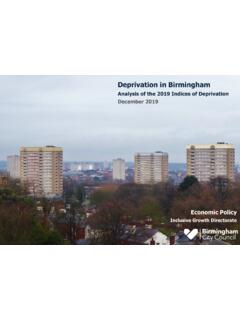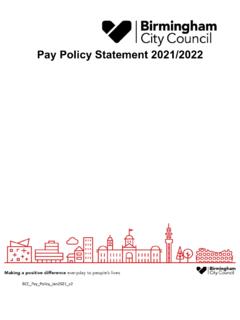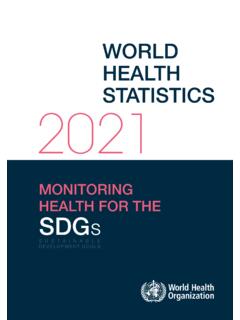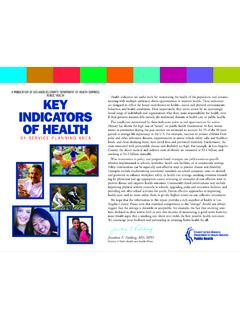Transcription of BIRMINGHAM HEALTH PROFILE 2019
1 1 BIRMINGHAM HEALTH PROFILE 2019 2 Contents Introduction .. 3 Demographics .. 4 Life expectancy .. 5 Causes of early death .. 5 Child HEALTH .. 7 Infant mortality .. 7 Child obesity .. 8 Child educational attainment .. 9 Child protection .. 10 Children in care .. 10 Child mental HEALTH .. 11 Working Age Adults .. 12 Smoking .. 12 Alcohol .. 12 Substance misuse .. 14 Learning disability and employment .. 15 Older Adults .. 16 Social isolation .. 16 Pension claimants .. 17 Admissions for falls .. 18 End of life care .. 19 Healthy Environment .. 20 Deprivation .. 20 Life expectancy inequality .. 21 Air quality .. 22 Becoming a food smart city .. 24 Fuel Poverty .. 25 Overcrowding .. 26 A&E Hospital Attendances .. 27 Disease Breakdowns .. 28 Cardiovascular disease (CVD) .. 28 Diabetes .. 34 Cancer .. 36 Respiratory .. 38 3 Introduction This PROFILE is one of a series of reports containing demographics and data relating to the HEALTH and wellbeing of the citizens of BIRMINGHAM at a local area level.
2 BIRMINGHAM s HEALTH and social care organisations use a locality model to deliver services across the city. BIRMINGHAM has 5 localities each made up of 2 constituencies. These are: Central: Hall Green and Selly Oak constituencies East: Hodge Hill and Yardley constituencies North: Erdington and Sutton Coldfield constituencies South: Edgbaston and Northfield constituencies West: Ladywood and Perry Barr constituencies. BIRMINGHAM Public HEALTH are currently consulting on a draft vision and strategy which is to improve and protect the HEALTH and wellbeing of BIRMINGHAM s population by reducing inequalities in HEALTH and enabling people to help themselves. These are our draft priorities which are underpinned by addressing HEALTH inequalities and an intention to maximise the public HEALTH gains from hosting the Commonwealth Games in 2022. Figure 1 Draft BIRMINGHAM Public HEALTH Priorities 2019 There is a variety of information available on each local area, including demographics and public HEALTH priorities.
3 These profiles allows HEALTH and care organisations to identify public HEALTH issues in their local area and work with BIRMINGHAM Public HEALTH to improve local services. 4 Demographics Figure 2 - BIRMINGHAM population pyramid. Source: ONS 2017 MYE It is estimated that there are approximately 1,137,150 people living in BIRMINGHAM (ONS 2017 mid-year estimates). Of these are male and are female. The population are predominately aged under 45 years old (72%). The 2011 Census estimated that were from Black, Asian and Minority Ethnicity groups as opposed to 42% within BIRMINGHAM as a whole and 15% nationally. During 2013 to 2017 BIRMINGHAM saw just over 102,000 migrants register with GPs across the city. 5 Life expectancy Life expectancy in BIRMINGHAM is lower than the national average, for males life expectancy at birth is years (England ) and females years (England ). Figure 3 - Life expectancy for BIRMINGHAM compared to England. Source: ONS Deaths Life expectancy has increased in BIRMINGHAM over the last 10 years however it has plateaued in the last few years and is lower than England average for both males and females.
4 Causes of early death The major HEALTH conditions contributing to premature mortality can be identified by the number of years of life lost due to people dying before the age of 75. The biggest single contributor to excess years of life lost is infant mortality. This is discussed later in this report. The other main causes of early death in BIRMINGHAM are coronary heart disease, lung cancer and alcoholic liver disease. 6 Figure 4 - Excess years of life lost in BIRMINGHAM excluding infant mortality. Source: ONS Deaths For the three main conditions contributing to early death in BIRMINGHAM , we have calculated the excess years of life lost for each locality. Across the city coronary heart disease is the main cause of early death with almost 3,200 excess years of life lost between 2014-2016. Table 1 - Excess years of life lost for main conditions. Source: ONS Deaths 2014-16 Excess Years Life Lost 2014-16 Locality Coronary Heart Disease Lung Cancer Alcoholic Liver Disease Central 770 185 62 East 178 329 178 North 353 310 419 South 395 -6 304 West 1,486 218 589 BIRMINGHAM 3,182 1,036 1,552 7 Child HEALTH Infant mortality BIRMINGHAM has the worst infant mortality rate of all the local authorities in the country per 1,000 live births (England ) (2014-2016).
5 Figure 5 - Infant Mortality Rate 2014-16 by ward map. Source: ONS Births The map shows that most wards are similar to the BIRMINGHAM average which is much higher than England. Bordesley Green, Heartlands and Ladywood wards shown in red have a higher infant mortality rate compared to the BIRMINGHAM average. 8 Child obesity BIRMINGHAM has a higher prevalence of child obesity. More than one in ten 4-5 year olds are obese ( ) and a quarter of all 10-11 year olds ( ) Figure 6 - Childhood obesity 4-5 year olds by locality. Source NCMP 2015/16-2017/18 Figure 7- Childhood obesity 10-11 year olds by locality. Source NCMP 201516-2017/18 9 Child educational attainment Figure 8 shows the percentage of children achieving a good level of development during their foundation year. Achievement in BIRMINGHAM is below the national average. Figure 8 Reception Year 2016/17 Attainment Percentage Figure 9 shows the percentage of children by locality achieving 5 or more A-C Grades at GCSE during 2016/17.
6 Achievement in BIRMINGHAM is similar to the national average. Figure 9 KS4 GCSE result Grades A to C 2016/17 Attainment Percentage 10 Child protection The figures below show the numbers of children in with a child protection plan (CPP) and those in the care of the local authority (CIC). These charts do not include those children whose place of residence cannot be identified (for child protection reasons) which are 21% of CIC and 7% of those with a CPP. Figure 10 Number of children under Child Protection Order August 20181 Children in care Figure 11 Number of children identified in care August 20182 1 Sourced from BIRMINGHAM CYPF data strategy team 11 Child mental HEALTH As part of the HeadStart Phase 3 bid an experimental mental HEALTH index was created using 30 indicators grouped into 5 sections (children and families, crime, economics, hospital activity and education).3 An overall score was created to give an indication of resilience and mental wellbeing.
7 Those areas with the lowest scores (shaded darkest on the map) are potentially more likely to have lower resilience and poorer mental wellbeing. Figure 12 : Experimental Mental HEALTH Index (10-16yrs). Source: HeadStart Strategy 2015 2 Sourced from BIRMINGHAM CYPF data strategy team 3 HeadStart Strategy Stage 3 2015 available online 12 Working Age Adults A BIRMINGHAM Public HEALTH priority for working age adults is to address the cumulative impact of unhealthy behaviours smoking and substance misuse. Smoking Smoking attributable deaths account for around half of all deaths across BIRMINGHAM each year. The chart shows the percentage of these deaths for each gender over 3 year rolling trends from 2010-2016. During this period there were a total of 21,288 deaths in the city that could be attributed to smoking. Within the age range 22% of male deaths were attributed to smoking and 14% of females.
8 Figure 13- Attributed smoking deaths. Source: ONS Death Alcohol Alcohol related deaths account for approximately 16% of all deaths within the 25 to 64 year age group each year across BIRMINGHAM . 13 Figure 14- Chart showing alcohol related deaths 25-64. Source: ONS Deaths 2010-2016 Hospital admission rates for alcohol related admissions rates for BIRMINGHAM between the ages of 25-64 have been high for the last three years. The chart below shows that they were higher than the national averages. The trend however is lowering. Figure 15- Chart of alcohol admission rates. Source: NHS Digital 2014-2017 14 Substance misuse Drug misuse is a significant cause of premature mortality in the UK. Analysis of the Global Burden of Disease Survey 2013 shows that drug use disorders are now the third ranked cause of death in the 15 49 age group in England. BIRMINGHAM Public HEALTH commission drug treatment services for the city. The chart above shows the death rates between 2014/16 for each BIRMINGHAM locality that are specifically related to drugs (not including alcohol).
9 Intentional and unintentional deaths are included. Figure 16 Number of deaths from drugs. Source: ONS Deaths Hospital admission rates for substance misuse for 25 to 64 year olds are shown below. Broken down by core cities, these are inpatient admissions for mental and behavioural disorders, toxic effects and poisoning. Figure 17 - Chart of DSRs for substance misuse. Source: NHS Digital HES 2012-2015 15 Learning disability and employment The proportion of supported working age adults with learning disability in paid employment is an indicator in the Adults Social Care Outcomes Framework. BIRMINGHAM has one of lowest proportions in the country with less than 1% in employment during 2017/18. Nationally approximately 6% of people with learning disability have paid employment (ASCOF 2016-17). Figure 18 - Adults with LD in paid employment by locality. Source: Adults Social Care data 2017/18 16 Older Adults Social isolation People who feel socially isolated have a 30% higher risk of early The map below shows the relative risk of loneliness based on Census 2011 information on marital status, HEALTH status, age and household size.
10 Figure 19: Loneliness Index age 65+ by BIRMINGHAM LSOA. Source: Age UK BIRMINGHAM contains the largest number of areas where there is a very high risk of loneliness amongst older adults. 4 Holt-Lunstad J, Smith TB, Baker M, et al. Loneliness and Social Isolation as Risk Factors for Mortality - A Meta-Analytic Review, Perspectives on Psychology. Published online March 11 2015 17 Pension claimants Figure 20: Pension Claimants per 1,000 2017. Source: NOMIS BIRMINGHAM contains large areas who were claiming a pension during 2017 indicating there are pockets of elderly residents and those with disabilities located in this area. 18 Admissions for falls Figure 21: Number of Falls Admissions 65+ Source: NHS Digital HES Between April 2013 and March 2018 there were approximately of 23,350 admissions across BIRMINGHAM for falls related conditions. Figure 22: Number of mental HEALTH Admissions 65+ (excluding Dementia) Source: NHS Digital HES Between April 2013 and March 2018 there were approximately of 45,000 admissions across BIRMINGHAM for mental HEALTH conditions excluding dementia.














